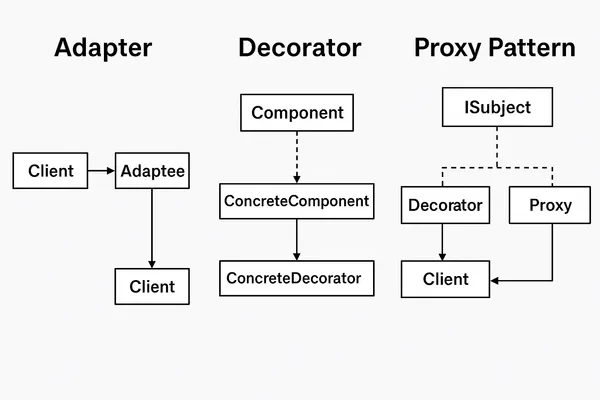Designing maintainable software often hinges on choosing the right pattern for the right job. Although Proxy, Decorator, and Adapter all involve wrapping another object, their intent, structure, and use cases diverge significantly.
🎯 Intent and Purpose
| Pattern | Intent | Typical Use Cases | Key Traits |
|---|---|---|---|
| Proxy | Control access to an object | Security checks, lazy loading, remote method invocation | Acts as a placeholder, can restrict or delay access |
| Decorator | Add new behavior dynamically | Logging, formatting, input validation | Preserves interface, stacks behaviors flexibly |
| Adapter | Convert one interface to another | Legacy system integration, third-party APIs | Doesn't modify original class, bridges mismatches |
🧩 Structural Similarities
- All are Structural Patterns.
- All wrap a target object.
- All implement or use an interface to interact with clients transparently.
🔍 Key Differences
| Feature | Proxy | Decorator | Adapter |
|---|---|---|---|
| Primary Goal | Access control or resource management | Behavior extension | Interface adaptation |
| Modifies behavior? | Sometimes | Yes | No |
| Client interface match? | Yes | Yes | No (converted) |
| Transparency | Often acts as the real object | Enhances the real object | Changes the way the client interacts |
| Example | API Gateway | Compression/Logging layers | Old API → New Interface |
📌 When to Use Each Pattern
Use Proxy when:
- You want to control access (authorization, lazy loading, remote access).
- You need to defer object creation until absolutely necessary.
Use Decorator when:
- You want to add extra behavior like logging or formatting without altering the base class.
- You need to combine behaviors dynamically (e.g., logging + compression).
Use Adapter when:
- You have incompatible interfaces that need to work together.
- You’re integrating a third-party or legacy system with a new API.
🤔 Ask Yourself These Questions
- Do I need to restrict, delay, or filter access? → Use Proxy
- Do I want to extend the behavior of an object without modifying it? → Use Decorator
- Do I need to make incompatible interfaces work together? → Use Adapter
🧠 Summary
| Pattern | Strength | When NOT to Use |
|---|---|---|
| Proxy | Access control, resource management | If you're not adding access logic or lazy logic |
| Decorator | Modular behavior extension | If behavior change can be done with subclassing |
| Adapter | Interface compatibility | If the target and adaptee already share an interface |
📸 Visual Summary

🔗 Related Posts
- Proxy Pattern: Control Access and Enhance Behavior
- Decorator Pattern: Enhancing Behavior Dynamically
- Adapter Pattern: Bridging Interface Gaps
✅ Final Thoughts
These three patterns may seem similar, but their intent makes all the difference. By understanding the motivation behind each, you'll make better architectural decisions and write more modular, adaptable code.

